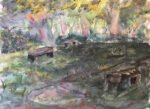As I said in the last post, I felt like I could do a second…

Avebury Stones
I was ready today to take a second stab at painting something with the Schmincke Shire watercolours. I learned some lessons from my first go that I’ve incorporated into this one. First, the set needs to be supplemented by a red and by a blue that’s suitable for skies. So my supergranulating palette of 12 now includes the Shire and tundra sets plus rose dore and cerulean blue. I think those two extra colours could come in useful for the tundra set too. There was a transparent yellow in one pan that I thought at one point might complement the tundra set but I now know better.
The second lesson was subject matter. These Shire colours need fields and rolling hills to bring out their strengths. A clearing in some woods wasn’t going to cut it. So I mentally moved to middle England and settled on these stones at Avebury. Avebury apparently has several stone circles. I don’t know which one this is, which is unfortunate, but to be honest it’s the hills that are more important here as they’ll be where the supergranulators work.
After putting down a pencil drawing, I started with the masking fluid, as usual. I masked out the stones and did some spattering over the foreground, the hill behind it and a couple of fences. I had in my head a value plan where the stones would be light, standing out against a dark hill behind them but you’ll see this plan had to be changed.
Once the masking fluid was dry, I worked my way down the painting. The sky was in cerulean blue (Shire blue is too green for shies) with some clouds left white and some shire grey under the clouds. Then came the trees, where I had fun creating a variety of greens from the five shire colours and the rose dore. I wanted the greens to all be distinct against each other and for them to generally be darker in the middle of the painting and lighter at the edges. The painting was looking like a “colouring in job” at this stage, which may well be the way to go with both sets of supergranulating colours.
After the trees, the house and the small shapes in front of the house, I moved onto the big land shapes. For the hill and the grass under the stones, I used the Shire colours and the rose dore and tried to use as little paint as possible to aid the granulation. The hill is definitely the best of these shapes, with the granulation coming through clearly. In the grass under the stones, I’ve subtly made things darker with Shire grey where there should be shadows. I have light coming in from the right whereas my source photo has it coming from the left so I hope this isn’t a Westward-facing view. The shapes at the bottom had some rose dore and cerulean blue thrown in to keep them interesting and I think I managed to stop before creating mud. In fact all those land shapes have ended up interesting, with lots of colour variation.
At this stage, I spotted a composition problem. All the tree shapes at the top were similar sizes. So I added the line of greenery along the top of the hill. Is it a row of bushes? Or the tops of some trees behind the hill? Don’t know – you can choose.
After the masking fluid came off, I painted in the stones and the fences. The fences have a bit of Shire grey on their shadowy sides, especially wherever they’re in front of light values shapes. For the stones, I was faced with a value plan problem. The Shire set is quite light valued (with the exception of Shire grey) and I didn’t want light stones against a light background. So I made the shadowy sides really dark to contrast against the colours behind them. I wanted the light side of the stones to be really light but leaving them white looked wrong, so I dropped on some really watery shire grey with a bit of cerulean blue and rose dore in places for the most subtle colour effect that I’ve ever painted.
Finally, I stabbed in some grass and some colour with Shire grey, cadmium red and cadmium yellow. The grass around the stones needed a bit of texture in places and the painting as a whole needed some bubbles/acidity/not sure what the word is. And that was me done. I could have added some shadows to the left of the stones but I don’t think this painting needs them, in the same way that choppy seas don’t need reflections.
I like this one and it’s going up for sale. High spots for me are the gaps in some of the trees at the top and the way the rose dore complements the Shire colours. I definitely feel closer to understanding these Shire supergranulators and knowing when to use them.








Leave a Reply